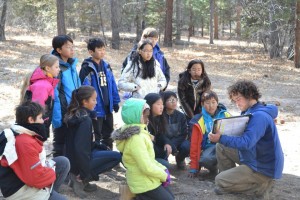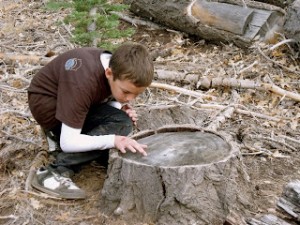One of the best and defining parts of an outdoor science school is that nature is our textbook and our classroom.
 Our students don’t sit at desks reading paragraphs aloud from a textbook and then demonstrate comprehension by flipping back through the chapter looking for definitions of key words to copy on to a worksheet. For our students, learning is something they experience with the whole of their being. Experiential education allows students of all learning styles to succeed.
Our students don’t sit at desks reading paragraphs aloud from a textbook and then demonstrate comprehension by flipping back through the chapter looking for definitions of key words to copy on to a worksheet. For our students, learning is something they experience with the whole of their being. Experiential education allows students of all learning styles to succeed.
Some students do retain information better when they see it—having what is called a visual learning style—so our instructors carry mini-white boards to diagram concepts, spell out vocabulary, and chart experiment results. The advantage to this over a textbook is that instructors can modify visual aids for their specific class, rather than using lowest-common-denominator text or graphics as might be found in a mass-published textbook. Along with more flexibility to tailor our materials to individual student needs, real life examples of class content are all around us for demonstration and running experiments.
 There is no separation of “lecture” and “lab” in experiential education, reflecting the needs students who learn best by doing and have a kinesthetic learning style. This style is apparent in our students’ lives outside of school. Athletes don’t excel by just reading a playbook, nor musicians learn piano by thumbing through a book of Beethoven’s symphonies. Each of our classes is based around activities that introduce and reinforce concepts through movement and an experiment that gives students an opportunity to practice hands on science.
There is no separation of “lecture” and “lab” in experiential education, reflecting the needs students who learn best by doing and have a kinesthetic learning style. This style is apparent in our students’ lives outside of school. Athletes don’t excel by just reading a playbook, nor musicians learn piano by thumbing through a book of Beethoven’s symphonies. Each of our classes is based around activities that introduce and reinforce concepts through movement and an experiment that gives students an opportunity to practice hands on science.
Not sharing a wall with the class next-door means that we can be loud, shout things, and sing songs without fear of disrupting another class.
This makes classes much more enjoyable for our students while also giving instructors more freedom in how they reach auditory learners. Whether it’s teaching students a song about the water cycle or rapping about decomposition, our instructors can make full use of their creativity to reach students.
At High Trails Outdoor Science School, we literally force our instructors to write about elementary outdoor education, teaching outside, learning outside, our dirty classroom (the forest…gosh), environmental science, outdoor science, and all other tree hugging student and kid loving things that keep us engaged, passionate, driven, loving our job, digging our life, and spreading the word to anyone whose attention we can hold for long enough to actually make it through reading this entire sentence. Whew…. www.dirtyclassroom.com


Comments are closed.